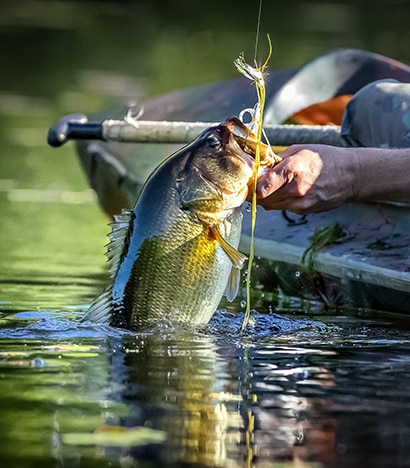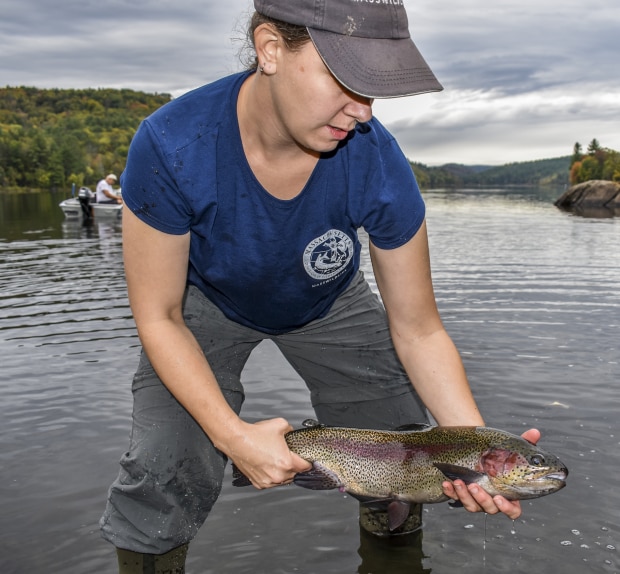Remember, you need a fishing license if you’re 15 or older. Buy your fishing license online.
Fall bass fishing tips
Largemouth bass are arguably the most popular freshwater recreational fish due to their large size, fast growth, and incredible fight. Largemouth bass are similar to smallmouth bass, however largemouth bass have larger mouths (back edge of mouth extends past the eye) and a dark, broken horizontal bar pattern on their side, while smallmouth bass have smaller mouths (mouth doesn’t extend past eye) and vertical bars. Bass can be found in most waterbodies across Massachusetts. Below are some helpful tips about how you can target bass in the fall.
“Bass fishing in Massachusetts heats up as water temperatures cool down in the fall. In anticipation of a long, cold winter bass will school up and become more active, seeking out larger prey to "fatten up". Bass will congregate around remaining weed beds, currents, and drop-offs where schooling baitfish are plentiful. Fish metabolism is driven in large part by water temperature and bass will find shallow water in the fall, particularly late in the day when the water is the warmest. Bass feed heavily as the water temperatures drop from the 70s down to the 50s, and the fall is a phenomenal opportunity to catch the "fish of a lifetime". Popular and highly successful tactics for fall bass fishing include using large swimbaits that mimic forage such as yellow perch, bluegills, and even stocked trout. Bass are opportunistic feeders and a large, slow moving swimbait is difficult for even the most wary fish to pass up. Additionally, jigs that mimic crayfish and other small presentations such as jerkbaits and shallow diving crankbaits that imitate baitfish in shallow water are highly effective.”—Cameron Young, MassWildlife Palmer Fish Hatchery Technician and Avid Bass Angler
“Fall is one of my favorite times of the year to be on the water, the fish are more active and there are fewer anglers so I have many lakes all to myself! As day length shortens, game fish are triggered to actively feed. Anglers should keep in mind that baitfish are moving from the main lake areas at this time and into the mouths of coves and then further into the backs of coves as the fall season goes on. Bass, pickerel, and northern pike will follow the baitfish (food)–—so anglers should too! Whether you are fishing from the shore or from a boat, focus on the coves that are immediately adjacent to the main lake. Then cast to shallow water targets like grass, laydown logs, and docks. My favorite lures to cast in the fall are topwater baits, jerkbaits, spinnerbaits, square-billed crankbaits, and chatterbaits. I like to try various lure retrieve speeds to let the fish tell me which speed will get them to strike, from fast to slow, and stop and go. But in general I tend to retrieve lures more quickly in clear water and slower in darker stained waters.”—Gene Ellison, Professional Bass Angler and MassWildlife Angler Education Program Volunteer Instructor
“Bass learn before they are 1-year-old that they need to feed heavily in the fall in order to survive their first winter. As the worst of the summer heat passes, and prey spawned that year become large enough to target, bass start feeding more heavily. In many small ponds, especially those that are high in nutrients and plants, the summer can also slow down feeding because of low levels of oxygen since hot water doesn't hold as much oxygen as cooler water. Big swings in oxygen put the fish off feed for a while each day and can make fishing difficult in the summer. Cooler water temperatures in the fall, combined with plants dying back, allow the water to hold more oxygen and more consistent oxygen levels, leading the fish to feed all day and night. Active fish hold near drop-offs or weed edges, waiting to ambush prey, sometimes a change of just a couple feet or even inches of depth will be enough to hold fish in a cooler darker spot waiting for your lure or bait. Anglers can take advantage of MassWildlife’s Go Fish MA! Map to easily access bathymetry maps to get information about depth and drop-off points to target in the fall.”—Todd Richards, MassWildlife Assistant Director of Fisheries and Avid Angler
Want even more tips? Watch our video tutorial Finding Bass in Mass featuring Professional Bass Angler Gene Ellison, MassWildlife Watershed Project Leader Jason Stolarski, and MassWildlife Assistant Director of Fisheries Todd Richards as they talk about tips for catching bass, bass research, and more!
Fall trout stocking
Each fall, MassWildlife stocks 60-70 thousand trout in waterbodies across Massachusetts. Fall stocking, when combined with trout stocked in the spring, provides plenty of opportunities for residents and visitors to enjoy a day on the water.
Fall trout fishing tips
Fall trout fishing provides opportunities for all types of anglers. If you like to fish from shore or boat, in lake or river, or with flies or worms, you have a great day waiting for you. As water temperatures cool, MassWildilfe is able to stock trout into waters that, only a month before, were too warm for coldwater fish. The temperatures will remain fine for trout from the end of September until the beginning of next summer. In early fall, lake and pond fishing can be better on darker days or in deeper water, but the water will continue to cool and the fish will spread out more over time. Fishing in rivers and streams is often better early and late in the day or on cloudy days. Read on for some more fall trout tips:
- Switch up your technique. Casting or trolling the same lure for hours without changing the color, shape, or action can be painfully boring. If a spoon isn’t working, try a spinner or minnow plug. Why have a box full of lures and not use them? Can’t find them deep? Try shallow. If you find a combination that works, keep casting in the same area. Stocked trout tend to school together after spending time in the hatchery with their age class. Even weeks after stocking, the fish can often be found schooled up. Be ready to switch locations each time you go fishing because the school might cruise quite a distance in a couple days.
- Stay quiet. Being quiet along the shore can dramatically improve your luck, particularly in rivers and streams. Fish in shallow water will swim quite a distance if spooked or might just bury under a rock until the threat goes away. Once you arrive at your fishing spot, try watching and waiting for several minutes on the shore before casting. Spooked fish will often bail to another hiding spot and then creep back to a feeding location when they feel safe.
- Know your trout. MassWildlife grows and stocks four types of trout: brook, brown, rainbow, and tiger trout. Click here to learn how to identify the different types of trout and tips for catching them.
Have a great fishing season! Buy your fishing license online. 100% of proceeds from fishing license fees go toward fish and wildlife conservation, as well as fish stocking, land protection, and habitat management.

